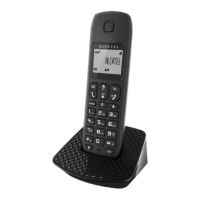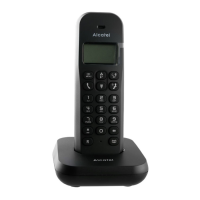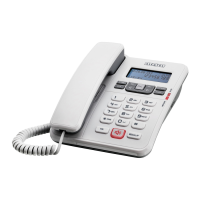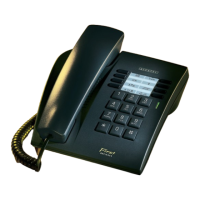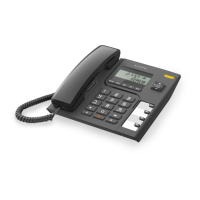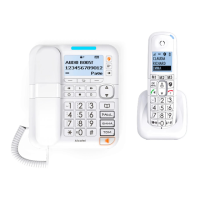Do you have a question about the Alcatel Easy Reflexes and is the answer not in the manual?
Describes specific telephone operations like lifting receiver or hanging up.
Explains the phone's screen and its display of information.
Describes programmable keys and their associated icons for services.
Details the numeric and alphabetic keypads for dialing and input.
Explains controls for loudspeaker and hands-free functions.
Covers fixed keys like Menu key and Fixed key functions.
Clarifies the meaning of symbols used in operation sequences.
Learn to make and answer calls using hands-free mode without lifting the receiver.
Step-by-step guide to making calls to external numbers.
Instructions for placing calls to internal extensions or colleagues.
How to find and call contacts using the company directory by name.
Instructions for accessing and dialing numbers from your personal contact list.
Guide to using the shared directory for external numbers.
Details on how to answer incoming calls and view caller information.
Learn to filter calls by using the voice mailbox screening feature.
How to redial the last dialed or received numbers.
Procedure to save a number for a future call if it did not connect.
How to set up an automatic callback when an internal line is free.
Instructions for answering internal calls hands-free via intercom.
Guide to sending DTMF tones for automated systems or answering machines.
Steps for initiating calls using the ISDN network.
Learn how to mask your caller ID for ISDN calls.
Procedure to request identification of malicious callers on ISDN.
How to enable the loudspeaker during an ongoing call with the receiver off hook.
Instructions on how to mute your microphone during a conversation.
How to add a second participant to an active call.
Procedure to handle an incoming call while already on a call.
Steps to transfer an ongoing call to another number or extension.
How to manage multiple calls by switching between them.
Guide to setting up and managing conference calls with multiple parties.
Instructions on how to put a call on hold and resume it later.
How to place an external call on hold and retrieve it from another terminal.
Learn how to manage and respond to incoming calls when busy.
Procedure to interrupt an internal call if authorized.
How to save a number to the directory during an active communication.
How to receive special ringing for calls directed to another number.
Procedure for answering outside calls indicated by a general bell when the operator is absent.
How calls are directed to secretaries for managers.
Instructions on how to answer a ringing phone in your pick-up group.
How to answer external calls that ring at the operator position.
Procedure to have calls directed to multiple terminals simultaneously.
Details on how calls are distributed among members of a hunting group.
How to page an internal contact who does not answer the phone.
Procedure to remotely activate a correspondent's loudspeaker.
How to send text messages to colleagues via the phone system.
Instructions on copying and sending voice messages to contacts.
How to record and send messages to single numbers or groups.
Procedure for broadcasting audio messages to groups.
How to answer a pager call from any system telephone.
How to transfer an external line to another terminal for making calls.
How to choose which types of calls (internal, external, all) to divert.
Instructions for immediately forwarding calls to a different number.
How to forward all calls to your personal voice mailbox.
Guide to enabling or disabling the personal assistant feature.
How to configure the personal assistant to use a single contact number.
Instructions on forwarding calls to a pager for mobile contact.
How to set up call forwarding to receive calls at your current location.
Procedure for diverting calls based on the caller's identity.
How to forward all calls designated for a group to another internal number.
Instructions on how to deactivate all call diversion settings.
How to automatically divert calls when your line is occupied.
Procedure to make your terminal temporarily unavailable for all incoming calls.
How to access and review messages left in your mailbox.
Instructions on leaving a message that will display on the screen of the calling terminal.
Guide to accessing and reading text messages received on your terminal.
How to charge external calls to specific business account numbers.
Procedure to check the cost of calls made on behalf of others.
How to charge external calls made from home or while traveling to the company account.
Steps to set up your voice mailbox, including recording your name and code.
How to replace the default greeting with a personal voice message.
Instructions for changing your personal access code for the voice mailbox and terminal lock.
Guide to choosing different ringtones and setting the call volume.
How to modify the brightness level of the telephone's display.
Procedure to change the display language of the telephone.
How to assign specific numbers or functions to direct call keys.
Instructions for adding, editing, and deleting contacts in your personal directory.
How to set up temporary or permanent reminders for callbacks.
Procedure to determine the specific terminal you are currently using.
How to play background music on the telephone's loudspeaker when not in use.
Instructions on how to lock the telephone to prevent unauthorized use or changes.
Describes specific telephone operations like lifting receiver or hanging up.
Explains the phone's screen and its display of information.
Describes programmable keys and their associated icons for services.
Details the numeric and alphabetic keypads for dialing and input.
Explains controls for loudspeaker and hands-free functions.
Covers fixed keys like Menu key and Fixed key functions.
Clarifies the meaning of symbols used in operation sequences.
Learn to make and answer calls using hands-free mode without lifting the receiver.
Step-by-step guide to making calls to external numbers.
Instructions for placing calls to internal extensions or colleagues.
How to find and call contacts using the company directory by name.
Instructions for accessing and dialing numbers from your personal contact list.
Guide to using the shared directory for external numbers.
Details on how to answer incoming calls and view caller information.
Learn to filter calls by using the voice mailbox screening feature.
How to redial the last dialed or received numbers.
Procedure to save a number for a future call if it did not connect.
How to set up an automatic callback when an internal line is free.
Instructions for answering internal calls hands-free via intercom.
Guide to sending DTMF tones for automated systems or answering machines.
Steps for initiating calls using the ISDN network.
Learn how to mask your caller ID for ISDN calls.
Procedure to request identification of malicious callers on ISDN.
How to enable the loudspeaker during an ongoing call with the receiver off hook.
Instructions on how to mute your microphone during a conversation.
How to add a second participant to an active call.
Procedure to handle an incoming call while already on a call.
Steps to transfer an ongoing call to another number or extension.
How to manage multiple calls by switching between them.
Guide to setting up and managing conference calls with multiple parties.
Instructions on how to put a call on hold and resume it later.
How to place an external call on hold and retrieve it from another terminal.
Learn how to manage and respond to incoming calls when busy.
Procedure to interrupt an internal call if authorized.
How to save a number to the directory during an active communication.
How to receive special ringing for calls directed to another number.
Procedure for answering outside calls indicated by a general bell when the operator is absent.
How calls are directed to secretaries for managers.
Instructions on how to answer a ringing phone in your pick-up group.
How to answer external calls that ring at the operator position.
Procedure to have calls directed to multiple terminals simultaneously.
Details on how calls are distributed among members of a hunting group.
How to page an internal contact who does not answer the phone.
Procedure to remotely activate a correspondent's loudspeaker.
How to send text messages to colleagues via the phone system.
Instructions on copying and sending voice messages to contacts.
How to record and send messages to single numbers or groups.
Procedure for broadcasting audio messages to groups.
How to answer a pager call from any system telephone.
How to transfer an external line to another terminal for making calls.
How to choose which types of calls (internal, external, all) to divert.
Instructions for immediately forwarding calls to a different number.
How to forward all calls to your personal voice mailbox.
Guide to enabling or disabling the personal assistant feature.
How to configure the personal assistant to use a single contact number.
Instructions on forwarding calls to a pager for mobile contact.
How to set up call forwarding to receive calls at your current location.
Procedure for diverting calls based on the caller's identity.
How to forward all calls designated for a group to another internal number.
Instructions on how to deactivate all call diversion settings.
How to automatically divert calls when your line is occupied.
Procedure to make your terminal temporarily unavailable for all incoming calls.
How to access and review messages left in your mailbox.
Instructions on leaving a message that will display on the screen of the calling terminal.
Guide to accessing and reading text messages received on your terminal.
How to charge external calls to specific business account numbers.
Procedure to check the cost of calls made on behalf of others.
How to charge external calls made from home or while traveling to the company account.
Steps to set up your voice mailbox, including recording your name and code.
How to replace the default greeting with a personal voice message.
Instructions for changing your personal access code for the voice mailbox and terminal lock.
Guide to choosing different ringtones and setting the call volume.
How to modify the brightness level of the telephone's display.
Procedure to change the display language of the telephone.
How to assign specific numbers or functions to direct call keys.
Instructions for adding, editing, and deleting contacts in your personal directory.
How to set up temporary or permanent reminders for callbacks.
Procedure to determine the specific terminal you are currently using.
How to play background music on the telephone's loudspeaker when not in use.
Instructions on how to lock the telephone to prevent unauthorized use or changes.


